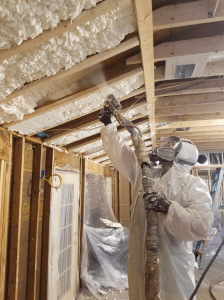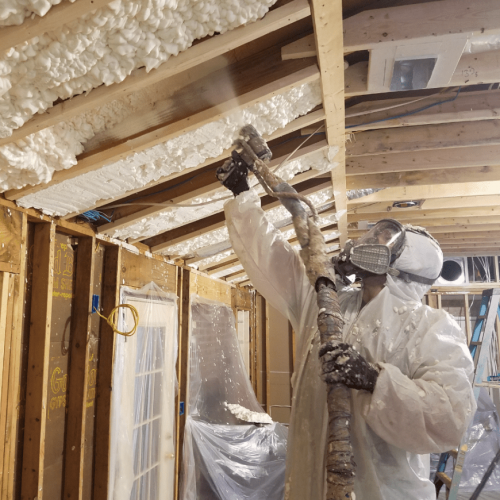
When I answered the phone, the homeowner said, “Mr. Bird, I need your help. Allison Bailes & Andy Bell at Energy Vanguard gave me your name & number, and said to call you”.
This homeowner had employed a company to encapsulate his attic with spray foam insulation. Oddly enough, we had also been called to provide a quote on this house, but the homeowner chose a competitor to spray his project.
His complaint was that there was a lingering smell in his house. In fact, the family was forced to live downstairs, avoiding the upstairs living area entirely.
I visited the house, and sure enough, there was a smell. Not much of one, but it was present. The foam was not the problem. The problem was applicator carelessness.
The competitor had sub-contracted a foam crew for the job. Odds are, this crew was a new construction crew, unaccustomed to the unique protocol necessary for retrofit projects. Their foam looked good. New construction crews can have lower prices per square foot, but it may come at a cost, as you will see.
What this crew had not done:
- Proper ventilation in the house and spraying area to purge chemical fumes with outdoor air changes.
- Isolate the spray area from the living spaces.
- Shut down the HVAC system that was contained in the attic.
- Educate the client.
The homeowner ultimately chose to sue the competitor. And it didn’t have to happen. This horrible experience probably would not have occurred if strict protocol had been followed on the day the crew sprayed that attic.
Often, a search on the internet for spray foam insulation will bring up a documentary from CBC News. This is a dramatic piece, with Halloween-like, haunted house background music and sound effects. The Canada news organization focuses on an experience with the Franciszkanie family. The post is dated October 2013.
According to the show, their spray foam insulation project was so unpleasant, they were forced to live in an RV. Oddly enough, it appears that they weren’t ventilating the house at all.
This family opted to have the entire ceiling of the house and the roof removed from their home and replaced. No mention was made as to what insulation was being installed in the remodel.
Bad news sells. The CBC News Youtube video has 2.8 million views.
I know of a cellulose insulation salesman who uses that Youtube video to dissuade homeowners away from spray foam.
In July 2016, spray foam chemical manufacturer, Icynene posted an informative video entitled “How to Avoid a Spray Foam Insulation Nightmare”, and their Youtube video has 27, 353 views. Hardly a blockbuster.
What strikes me is the ratio of “bad foam experiences” to positive foam experiences. The number of negative spray foam experiences for homeowners is a tiny, tiny fraction. In my 18 year experience, we’ve sprayed several thousand projects, with no lasting negative experiences. And remember, we are strictly a retrofit company… EVERY house we spray is occupied. We’ve had a handful of hiccups, but always recover to the enthusiastic satisfaction of our clients.
Here is my assessment of the negative experiences homeowners have shared:
1. Because sSPFpf (spray polyurethane foam) is made on site, it is susceptible to operator and equipment error, and the environmental conditions when spraying. If equipment isn’t calibrated & operating properly, you can get a mess. If operators are untrained, careless, or just forget something, you can get a mess. Basically, a spray foam insulation rig is a complex mobile science lab. (Think of SPF as 2-part epoxy, with air pockets).
2. When a spray foam crew spends most of their time spraying new construction buildings, there’s a huge mental shift required when they show up at your beautiful home.
- Drop Cloths; enough to cover your floors & stairs leading from front door to spray area.
- Educate the client. (Detailed conversation… in the English language).
- Plastic poly to protect contents, and HVAC (located in the spray area.) from spray fallout.
- Understanding of building science: Where to spray and how much to spray.
- How to prep the spray area; isolate the living space from the spray area; and clean-up that meets your high standards.
3. The bad reviews come from retrofit projects. Retrofit foam is far more complex to install properly than new construction foam. You’re hiring the guy pulling the trigger on the spray foam, and not so much the chemical company, or even the contractor. You need to be confident that he understands what he is doing.
There’s lots more. But you probably get the point. Installing Retrofit Spray Foam Insulation takes a Patient, Dedicated Retrofit- Experienced Crew.
The majority of poor reviews that I found centered on incomplete spray foam coverage. I surveyed the internet and Youtube for “Spray foam horror stories”; “Spray foam goes bad”, and other keyword searches for negative experiences from homeowners. Common storylines were, ‘This spot was missed’, ‘This area is not thick enough’, or ‘Look at the mess they left behind’. All human related. Issues that apply in every field of remodeling.
Do accidents occur when spraying foam? Yes, you bet they do. There is a human element, a technology element, a chemistry element, and the environmental element on the day we spray!
Hedge your bets by doing your homework, and select a contractor who puts your needs first.
If you’d like to receive a complimentary quotation from one of our Comfort Pro experts here at Bird Family Insulation, call us at 404-538-9168.
Stay tuned for my follow-up blog, “11 Tips for Selecting the Ideal Spray Foam Insulation Contractor for your Retrofit Project”.





